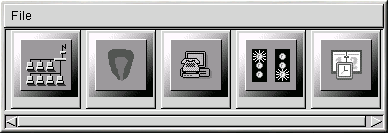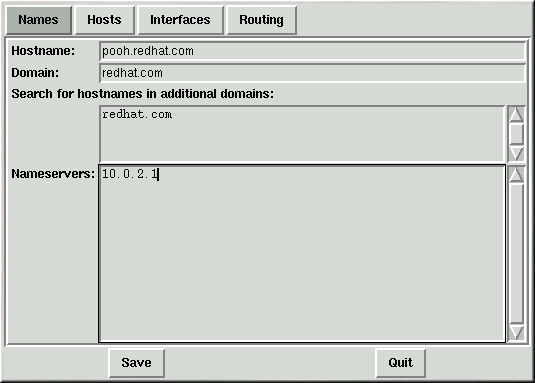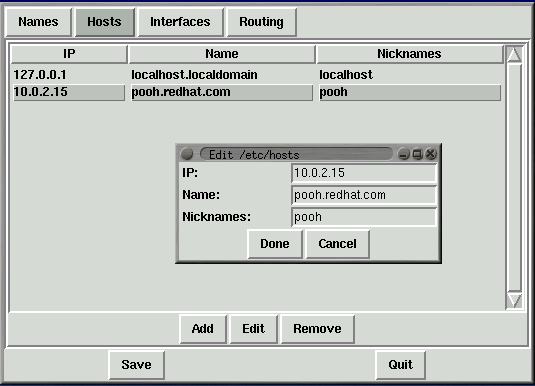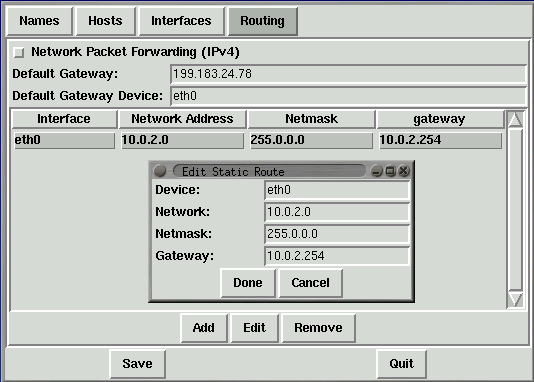Chapter 15. Control Panel
 | Note |
|---|---|
Most of what can be done with the Control Panel applications can also be done using linuxconf. |
The Control Panel is a launching pad for a number of different system administration tools (see Figure 15-1). These tools make system administration easier because you can configure your system without having to remember configuration file formats and awkward command line options.
To start the Control Panel, type control-panel at a shell prompt. You will need to be root to run the Control Panel tools and must be running the X Window System because it is a graphical utility. You can do this as well if you already have X running as a normal user. Just type su -c control-panel and then type the root password when prompted. If you plan to do other tasks as root, you can type su - followed by the root password when prompted.
 | Note | ||
|---|---|---|---|
If you are not running X as root, you might see the following error message:
|
After you have started the Control Panel, click on an icon to start a tool. Please note that you are not prevented from starting two instances of any tool, but doing so is a very bad idea because you may try to edit the same files in two places and end up overwriting your own changes.
 | Note |
|---|---|
If you do accidentally start a second copy of a tool, you should quit it immediately. Also, do not manually edit any files managed by the Control Panel tools while the tools are running. Similarly, do not run any other programs (such as linuxconf) that may change those files while the tools are running. |
Network Configurator
 | Note |
|---|---|
Documentation on network configuration using linuxconf can be found in the section called Network Configuration with Linuxconf in Chapter 14. |
Network Configurator, shown in Figure 15-2, allows you to easily manipulate parameters such as IP addresses, gateway addresses, and network addresses, as well as name servers and /etc/hosts.
To start Network Configurator start the Control Panel and click on the Network Configurator icon or type netcfg from a shell prompt.
Network devices can be added, removed, configured, activated, deactivated and aliased. Ethernet, ARCnet, Token Ring, pocket (ATP), SLIP, PLIP and loopback devices are supported. SLIP/PLIP support works well on most hardware, but some hardware setups may exhibit unpredictable behavior.
When using Network Configurator, click Save to write your changes to disk. To quit without making any changes, select Quit.
Managing Names
Network Configurator's Names panel serves two primary purposes: setting the hostname and domain of the computer and determining which name server will be used to look up other hosts on the network. The Names panel can not configure a machine to be a name server. To edit a field or add information to a field, simply click on the field with the left mouse button and type the new information.
Managing Hosts
In the Hosts management panel, you can add, edit, or remove hosts from the /etc/hosts file. Adding or editing an entry involves identical actions. An edit dialog box will appear. Simply type the new information and click Done when you are finished. See Figure 15-3 for an example.
Adding a Network Interface
If you have added a network interface to your machine since installing Red Hat Linux, or if you didn't configure your Ethernet card at install time, you can configure it here with a few clicks of a mouse.
 | Note |
|---|---|
You may need to configure kmod to load a driver for the network interface you are adding (e.g., eth0); see the section called Loading Kernel Modules in Chapter 16 for more information. |
Begin adding an interface by clicking on the Interfaces in the main panel. A list of configured devices and a row of available options will be displayed; see Figure 15-4.
To add a device, first click the Add button. Then select the type of interface you want to configure from the box that appears.
 | Note |
|---|---|
A clone button is now available in Network Configurator. This button can be used to create a "clone" of an already-existing interface. Using clone interfaces, a laptop can have one Ethernet interface defined for a work LAN, and a clone Ethernet device defined for a home LAN. |
SLIP Interface
To configure a SLIP interface, you must first supply a phone number, login name, and password. This will supply the initial parameters for the chat script needed to establish a SLIP connection. When you choose Done, a dialog titled Edit SLIP Interface appears that enables you to further customize the hardware, communication and networking parameters for your SLIP interface.
PLIP Interface
To add a PLIP interface to your system, you only have to supply the IP address, the remote IP address, and the Netmask. You can also select whether you want to activate the interface at boot time.
Ethernet, ARCnet, Token Ring and Pocket Adapter Interfaces
If you are adding an Ethernet, ARCnet, Token Ring or pocket adapter to your computer, you will need to supply the following information:
Device — This is determined by netconfig based on the devices already configured.
IP Address — Enter an IP address for your network device.
Netmask — Enter the network mask for your network device. The network and broadcast addresses are calculated automatically based on the IP address and netmask you enter.
Activate interface at boot time — If you want the device to be configured automatically when your machine boots, select this option.
Allow any user to (de)activate interface — Check this if you want any user to be able to activate or deactivate the interface.
Interface configuration protocol — If you have a BOOTP or DHCP server on your network and would like to use it to configure the interface, choose the appropriate option; otherwise, choose none.
After providing the configuration information for your new device, click Done. The device should appear in your Interfaces list as an inactive device. (The active column should have a label of no.) To activate the new device, first select it with a mouse click and then choose on the Activate button. If it does not come up properly, you may need to reconfigure it by choosing Edit.
Managing Routes
In the Routing management screen you have the ability to add, edit, or remove static networking routes. Adding or editing an entry involves identical actions, just like the Hosts panel. An edit dialog box will appear; simply type the new information and click Done when you are finished. See Figure 15-5 for an example.




